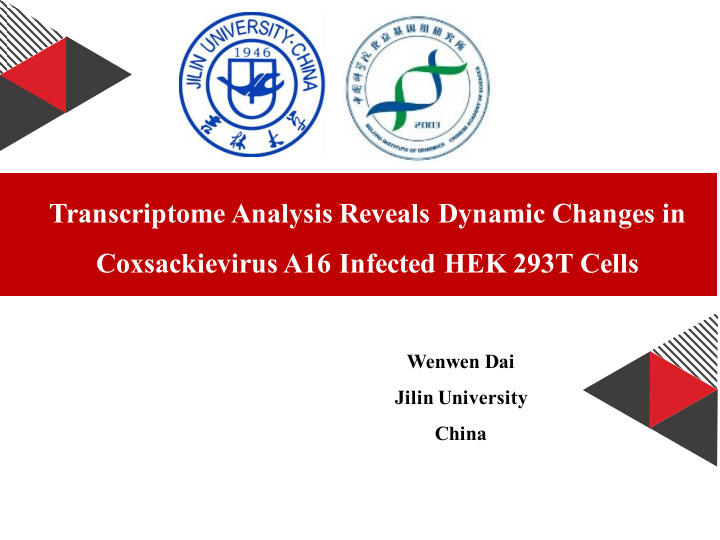



Transcriptome Analysis Reveals Dynamic Changes in Coxsackievirus A16 Infected HEK 293T Cells Wenwen Dai Jilin University China
Clinical manifestations of Hand, Foot and Mouth Disease HFMD primarily affects children younger than 5 years old and displays a wide range of clinical manifestations death Acute flaccids Aseptic meningitis and brainstem meningitis Vesicular eruptions on skins of hand feet and oral cavity
Epidemiology of Hand, Foot and Mouth Disease Asia-Pacific region HFMD have been a great public health concern so far 2millions of hundreds infections of deaths
Pathogens of HFMD, co-infection and recombination HFMD is caused by Enterovirus . Among them, EV71 and CV A16 are the most prevalent EV71 Acute central nervous system syndromes Coinfection HFMD CV A16 mild and self-limiting syndromes Recombination Has contributed to majority of HFMD cases for decades large outbreaks and evolution of both viruses Greater attention should be paid to investigations of CVA16 infection mechanisms
Structure of CVA16
Life cycle of CVA16 attach to cellular receptors and enter via endocytosis Viral RNA release through translates into a cellular exit polyprotein route CVA16 life cycle Polyprotein is New RNAs are processed to 11 packaged into individual progeny virions proteins Proteins induce membranous structures for RNA replication Graphical overview of CV A16 life cycle
Transcriptome study Uninfected cell CV A16 infected cell Transcriptome mRNA miRNA expression expression profile profile how CVA16 infection affects the function of a cell and the related regulatory mechanisms markers of EV71-related clinical symptoms in different tissues or cells transcriptome profile of CVA16 infected cells is still largely unknown
Next-generation sequencing of mRNA / miRNA and data processing supernatant Mock Illuminna Hiseq 2000 CVA16 15h Next generation sequencing cell lysates 293T miRNA-seq mRNA-seq human reference genome sequences mapped clean short reads ENSEMBL62/GRCh37 Burrows-Wheeler Aligner (BWA) mapped human pre-miRNA SHRiMP2 software gene density identify gene density DEGseq identify DEGseq Differentially expressed mRNA and miRNA, as well as target genes would be identified Differentially Differentially expressed predict Differentially expressed gene gene targeted by miRNAs expressed miRNA RNAhybrid 2.1 and miRanda3.3 algorithms
mRNA and miRNA expression profiles mRNA profile miRNA profile 1954 differentially expressed mRNA 51 differentially expressed miRNA 29up-regulated 1825up-regulated 22 down-regulated 129 down-regulated SCARB2 gene was the most differentially expressed target gene Red: infected Blue: uninfected Top 10 differentially expressed
The expression regulation of SCARB2 in CVA16-infected cells SCARB2 mRNA copies human scavenger receptor class B member 2 and CVA16 SCARB2 protein levels hsa-miR-3605-5p SCARB2 is ubiquitously distributed and is a common receptor for all clinically isolated CVA16 and EV71. Up-regulation of SCARB2 may increase the chance of co-infection ,which would partly explain the co-circulation and genetic recombination of EV71 and CVA16
Function analysis of differentially expressed mRNA target genes Differentially expressed mRNA target gene identify Gene ontology from DA VID database functional categories
Function analysis of differentially expressed mRNA target genes Differentially expressed genes were enriched in the regulation of cellular processes, cellular macromolecule metabolic processes and regulation of metabolic processes.
Function analysis of differentially expressed miRNA target genes Differentially expressed target gene KEGG pathway from DA VID database Differentially expressed target genes were clustered into four functional pathways, especially the ECM-receptor interaction and the Circadian rhythm pathways
ECM-receptor interaction and circadian rhythm pathways circadian rhythm pathways ECM-receptor interaction oral ulcers of Behcet’s disease Sleeping sickness of inflammation of symptoms of meningitis the airway CVA16 ECM-receptor interaction and circadian rhythm pathways may be involved with the pathogenicity of CVA16 cardiac pathology
ECM-receptor interaction and circadian rhythm pathways Green: down -regulation Regulation relation networks between the differentially expressed genes and miRNAs Yellow: up-regulation hsa-miR-100-5p hsa-miR-3607-3p hsa-miR-378c ITGA3 hsa-miR-106a-5p hsa-miR-3614-3p NR1D1 hsa-miR-106a-5p hsa-miR-378g CHAD hsa-miR-1248 hsa-miR-362-5p CSNK1D hsa-miR-1294 hsa-miR-423-5p AGRN hsa-miR-1273g-3p hsa-miR-3660 CLOCK hsa-miR-148b-5p hsa-miR-4510 COL5A1 hsa-miR-1294 hsa-miR-378c PER1 hsa-miR-149-3p hsa-miR-5001-5p COL5A2 hsa-miR-146a-3p hsa-miR-378d PER2 hsa-miR-331-3p hsa-miR-5010-5p HSPG2 hsa-miR-148b-5p hsa-miR-378f hsa-miR-3614-3p hsa-miR-589-3p LAMA3 hsa-miR-149-3p hsa-miR-378g LAMA5 hsa-miR-187-3p hsa-miR-423-5p most of the differently expressed genes in the two TNXB hsa-miR-193b-5p hsa-miR-4259 pathways were modulated by miRNAs hsa-miR- COL11A2 hsa-miR-2277-5p hsa-miR-4510 149-3p and hsa-miR-5001-5p LAMA4 hsa-miR-3126-5p hsa-miR-5001-5p ITGA7 hsa-miR-3127-3p hsa-miR-5096 ITGA2 hsa-miR-3187-3p hsa-miR-665 GP1BA The down-regulation of two miRNAs results in up-regulation of genes in ECM-receptor interaction hsa-miR-331-3p hsa-miR-7-5p and circadian rhythm pathways and are related to clinical symptoms of patients infected with CVA16 hsa-miR-3605-5p hsa-miR-92b-5p hsa-miR-3607-5p
Conclusions Elucidated the changes in cells upon CVA16 infection at transcriptome level Up-regulated SCARB2 and genes in ECM-receptor interaction and circadian rhythm pathways Provide novel insight into the pathogenesis of HFMD induced by CVA16 infection
Acknowledgement Prof. Jiang Chunlai (姜春来) National Engineering Laboratory for AIDS Vaccine of School of Life Sciences in Jilin University Prof. Su Weiheng (苏维恒) BIG Data Center of Beijing Institute of Genomics in Prof. Xiao Jingfa (肖景发) Chinese Academy of Sciences Prof. Li Rujiao (李茹姣)
Recommend
More recommend